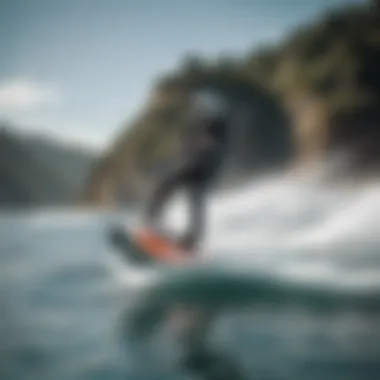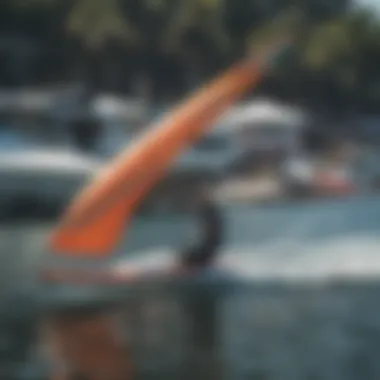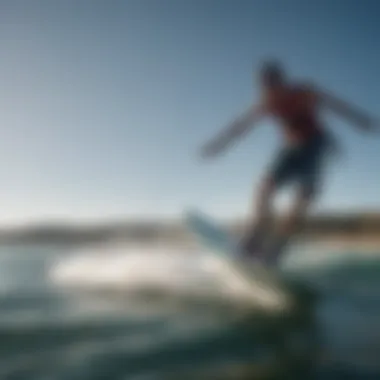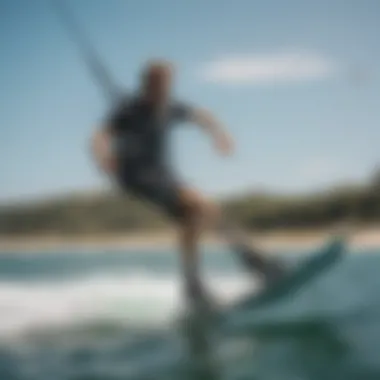Navigating the Used Hydrofoil Market for Kiteboarding


Intro
In recent years, kiteboarding has evolved, attracting not just thrill-seekers but also those who value sustainable practices in sporting activities. The allure of soaring across waves propelled by the wind is now intertwined with a growing interest in used equipment, particularly hydrofoils. For enthusiasts looking to minimize expenses while still enjoying their favorite sport, the market for used hydrofoils offers a promising alternative.
By purchasing pre-owned hydrofoils, kiteboarders can explore product options that don’t break the bank. However, the process of selecting the right gear can be daunting for many. With various factors to weigh, such as performance, durability, and where to find reliable purchasing avenues, having thorough knowledge becomes essential.
This piece intends to serve as a guide, navigating readers through the intricacies of the used hydrofoil market. We will discuss how to assess different types, their features, and how they can enhance your overall kiteboarding experience. With this understanding, kiteboarders can make informed decisions, championing sustainability while improving their game.
Gear Selection
When venturing into the market for used hydrofoils, gear selection stands as a pillar of your decision-making process. Understanding the components of a hydrofoil and how they interact with kites and boards is critical. Each piece affects your performance and enjoyment.
Types of Hydrofoils
Hydrofoils come in various types, each catering to different riding styles and conditions. Here are the most common:
- Freeride Hydrofoils: Best suited for beginners and intermediate riders, offering stability and ease of use.
- Race Hydrofoils: Tailored for advanced riders seeking speed and performance.
- Surf Foils: Excellent for those who wish to ride small waves and catch swells effortlessly.
Understanding these types is crucial as each will offer divers capabilities that could match— or clash— with your existing gear.
Choosing the Right Board
Pairing the right board with your hydrofoil is as critical as selecting the hydrofoil itself. The board's size and style can complement the hydrofoil's performance. Here are some considerations:
- Board Size: Consider your weight and skill level. Lightweight boards may be challenging for beginners but offer great performance for experienced riders.
- Board Type: Ensure that your board is compatible with the hydrofoil. You may find boards labeled specifically for hydrofoiling that allow for a seamless connection.
By paying attention to both your board and hydrofoil, you will set the stage for an optimized kiteboarding experience.
Skill Development
Once you have selected your gear, focusing on skill development is next. Mastering techniques and improving your abilities goes hand in hand with equipment choices.
Essential Techniques
When it comes to riding with a hydrofoil, there are a few essential techniques to learn:
- Proper Stance: Maintain a centered position, allowing your weight to distribute evenly across the board.
- Balance: The transition from riding flat to foiling requires balance adjustments, as you'll spend more time above the water.
- Speed Control: Learn to control speed effectively; too much can lead to instability, while too little may prevent you from taking off.
Progression Tips
For those eager to enhance their abilities, consider these progression tips:
"Practice makes perfect; don't shy away from smaller or calmer waters to build confidence before tackling bigger waves."
- Start with Easy Conditions: Begin in lighter winds and calm waters.
- Seek Instruction: Connecting with experienced instructors can provide invaluable insights and accelerate your learning curve.
- Frequent Practice: The more time you spend on the water, the better you'll become. Aim for consistent sessions to develop muscle memory.
By honing in on these skills, kiteboarders can ensure that their equipment choices translate into effective and enjoyable riding.
Ultimately, navigating through the used hydrofoil market entails understanding the nuances of gear selection and skill development. This foundational knowledge empowers kiteboarders to make smart, sustainable decisions that enhance both their experience and connection to the sport.
Understanding Hydrofoils
Hydrofoils present a remarkable intersection of engineering and recreational activity, particularly in kiteboarding. Understanding hydrofoils is essential for anyone looking to navigate the waters of this used gear market. Hydrofoils, which elevate the board above water, reduce drag and allow for smoother rides even in choppy conditions. This not only enhances performance but also opens up new possibilities in terms of speed and maneuverability.
The significance of comprehending hydrofoils extends beyond mere technicalities. For kiteboarders, a solid grasp of how these devices operate can be the difference between a mediocre experience and one that resonates with thrill and satisfaction. When considering used hydrofoils, enthusiasts should factor in essential elements like design, materials, and technology advancements that can influence both performance and longevity. This knowledge serves as a crucial compass for making informed purchasing decisions in the realm of second-hand gear.
The Basics of Hydrofoil Technology
At its core, hydrofoil technology involves a structure resembling wings that extend below the water’s surface, lifting the kiteboard above the water as it gains speed. The primary components of a hydrofoil include the mast, fuselage, and wings. Each plays an integral role in ensuring stability and performance.


First off, let's talk mast. Typically made from carbon fiber or aluminum, it serves as the vertical beam connecting board to the wings. Its length is significant; longer masts can handle rougher waters but may take some getting used to.
Then, we have the fuselage, which connects the wings to the mast. A sturdy fuselage translates to better control, especially during maneuvering.
Lastly, the wings are pivotal in generating lift. They come in various shapes and sizes, impacting aspects like speed and turning radius. Understanding these elements will undoubtedly bolster one’s confidence in selecting the appropriate used hydrofoil.
How Hydrofoils Enhance Kiteboarding Experience
Hydrofoils are game-changers for kiteboarding. The main allure stems from their capability to lift the rider above the waves. That means less drag and more speed. Whether you’re a beginner or have been riding the waves for years, foiling allows for a higher performance ceiling.
Moreover, using a hydrofoil transforms even light wind days into enjoyable outings. When wind conditions would typically derail a kiteboarding trip, hydrofoils maintain lift and responsiveness, enabling longer rides regardless of breeze intensity.
The sensation of gliding above the water provides a unique thrill and is an attractive proposition for many kiteboarders. This creates an interesting option in the used market, as seasoned riders often look to upgrade their tech while newcomers seek cost-effective ways to join the fray.
Additionally,
investing in used hydrofoils offers both financial savings and an opportunity to contribute to a sustainable cycle in kiteboarding. As the sport grows, fostering an awareness of environmental impacts becomes crucial, turning the used hydrofoil market into a viable choice for ecologically-minded kiteboarders.
In summary, understanding hydrofoils isn’t just about knowing how they work; it's about appreciating how they can redefine one’s kiteboarding experience. Whether minimizing costs or maximizing excitement, hydrofoils are an essential topic for those keen to dive into the world of used gear.
The Appeal of Used Hydrofoils
In the world of kiteboarding, where the thrill of gliding over water fuels a passion that many enthusiasts live for, the option of buying used hydrofoils holds significant value. This segment navigates the allure of this market, dissecting both the economic advantages and the broader implications of choosing second-hand equipment.
Cost-Effectiveness versus New Gear
The conversation around cost typically dominates any discussion about gear acquisition, and hydrofoils are no exception. New hydrofoils can cause a dent in one’s wallet, with prices often soaring into the thousands. However, purchasing a used hydrofoil can present a more palatable option for kiteboarders on a budget. A used hydrofoil can deliver excellent performance at a fraction of the cost, enabling more riders to participate in the sport without breaking the bank.
Many enthusiasts find that they can invest in a previous model from reputable brands, which may still boast impressive technology. Given the rapid advancements in hardware, last season’s models can often be just as effective as the latest releases, especially for recreational users who may not require the cutting-edge performance that comes with every new design. When making a choice between used and new, it’s wise to weigh the mechanical condition and overall wear of the gear. A thorough inspection can reveal whether a used foil is worth the investment or if it's simply a money pit.
Some kiteboarders have reported finding used hydrofoils that were lightly used, sometimes only a few times, creating a scenario where they enjoyed significant savings without compromising on quality. Whether it’s about getting into the sport for the first time or upgrading your setup, the used market offers a treasure trove of opportunities for cost-effective purchases.
Environmental Considerations in Purchasing Used Equipment
The eco-conscious kiteboarder recognizes that the choices made today can ripple through the environment for years to come. By opting for used hydrofoils, enthusiasts contribute to a culture of sustainability. Every used piece of gear purchased is one less item that ends up in a landfill, showcasing a simple yet profound way to align personal interests with environmental stewardship.
When you consider that manufacturing new hydrofoils requires natural resources, energy, and labor, the benefits of reusing equipment become crystal clear. Not only does this choice help minimize waste, but it also decreases the demand for new products, thus potentially encouraging manufacturers to contemplate more sustainable practices in their production processes.
"Buying used isn’t just about saving money; it’s also about making smarter, more sustainable choices that benefit our planet."
Additionally, the social aspect of buying used can’t be overlooked. Typically, used hydrofoils are found in local communities or online forums where involved kiteboarders share tips and experiences, creating connections that enrich the sport. Engaging in community exchanges not only fosters a sense of camaraderie but also allows enthusiasts to share knowledge about gear maintenance—further promoting sustainability.
Key Factors to Consider When Buying Used Hydrofoils
When it comes to acquiring a used hydrofoil, understanding key factors is paramount for making an informed decision. These factors not only influence the performance and usability of the gear but also significantly affect the overall kiteboarding experience. As many kiteboarders know, investing in second-hand equipment can be a thoughtful way to manage expenses, but without a keen eye for detail, you might end up with a piece that doesn’t quite meet your expectations or needs.
Firstly, the condition and wear of a used hydrofoil is something you cannot overlook. Dings, scratches, and signs of wear and tear can be red flags, indicating that the board may have been through more than a couple of tough sessions on the water. Next is understanding the technical specifications, which include elements like the size of the wings, the material of the mast, and the design of the fuselage. Each of these components will impact how the hydrofoil performs in various conditions and can greatly determine your comfort and ability on the water.
Finally, consider performance and how well the used hydrofoil aligns with your individual kiteboarding style. Every rider has their own preference when it comes to speed, stability, and maneuverability. Understanding what you’re looking for can save you some heartache down the line—after all, a hydrofoil that works wonders for one might be a disappointment for another.
Condition and Wear Assessment
Before you settle on a used hydrofoil, meticulously assess its condition. Look closely at the running edges of the wings, as these are often the first places to show significant wear. A hydrofoil with deeply gouged edges might struggle to deliver the smooth ride you’d expect, leading to a frustrating experience on the water.
Check for any cracks or deformities on the mast and fuselage too. Even small cracks can expand over time, ultimately ruining your investment. It’s a good idea to ask for detailed photos or, even better, to inspect the hydrofoil in person if possible.
While a few scuffs may be inevitable, ensure that the overall structure of the hydrofoil is sound. If the seller is hesitant to allow for a thorough inspection, it might raise some red flags about the item’s true condition.
Understanding Technical Specifications
Grasping the technical specifications of a used hydrofoil is crucial for making that right choice. Hydrofoils come in various shapes, sizes, and materials, and each of these specifications directly influences performance. For instance, a larger wing is generally better suited for lighter winds, providing lift and stability. However, in high winds, you might find that a smaller wing is necessary for better control.


Other important specs include:
- Material: Look for hydrofoils made of durable materials like carbon fiber. They offer better strength-to-weight ratios, enhancing performance without sacrificing rigidity.
- Fuselage length: Longer fuselages can enhance stability and help with directional control, while shorter ones are often preferred for maneuverability.
- Mast height: This can affect how you interact with the water and whether you’re able to achieve the lift needed at given speeds.
Being familiar with these technical elements can help align your purchase with your personal riding style and preferences.
Performance and Compatibility with Kiteboarding Style
Finally, always evaluate how the used hydrofoil fits your kiteboarding style. Are you a rider who thrives on speed and trick execution, or are you more focused on a leisurely ride with friends? The hydrofoil should complement your approach to the sport.
Before sealing the deal, try to reach out to other riders who might have experience with the specific brand or model you’re considering. If possible, set up a demo session to see how it performs under your conditions and style.
A hydrofoil that matches your abilities and ambitions will not only enhance your performance but will also make your time on the water far more enjoyable. Remember, a used hydrofoil can be a gem, but only if it truly resonates with your riding needs and preferences.
Where to Find Used Hydrofoils
Finding the right used hydrofoil can feel like searching for a needle in a haystack. However, it’s a critical step for kiteboarding enthusiasts looking to save some cash without compromising on performance. As the market for used hydrofoils grows, new buying avenues pop up, giving buyers more options than ever. Knowing where to look makes the process smoother and more rewarding.
Online Marketplaces and Classifieds
The Internet is a treasure trove when it comes to finding used hydrofoils. Websites such as eBay and Craigslist often have a wide array of listings, from barely used gear to items that have seen better days. One key advantage here is the ability to easily compare prices and conditions across multiple listings, which can empower you during negotiations.
- Quick Searches: You can filter by region, condition, or price range, making your search as specific as needed.
- User Ratings: Many platforms have user ratings that can give you insight into the reliability of the seller.
- Photo Quality: Look for listings with clear images; they can speak volumes about the condition of the hydrofoil.
However, proceed cautiously; not all sellers are straightforward. A thorough examination of the item and seller feedback can save one from unexpected hassles.
Local Retailers and Trade Shows
Local shops that specialize in kiteboarding gear are often prime spots to find used hydrofoils. These establishments usually have knowledgeable staff who can offer personal insights into the products they sell and help buyers understand what components are crucial for their style of kiteboarding.
- In-Person Visits: Getting hands-on with the gear can be a game-changer. Assessing the weight, shape, and overall build can give you a more genuine feel than a photograph.
- Trade Shows: Attend kiteboarding expos or community fairs. Vendors often sell their inventory at reduced prices, and you might stumble upon a hidden gem amidst the new merchandise.
Engaging with local retailers or attending trade shows not only helps you find used equipment but can also create connections within the kiteboarding community.
Community Exchanges and Social Media Groups
Facebook groups and online forums such as Reddit can provide a vibrant space for buying and selling used hydrofoils. Community-driven platforms offer unique advantages because they combine trust and interest.
- Niche Groups: Joining specialized groups focused on kiteboarding can result in more targeted offers. Members often post their gear for sale, knowing other enthusiasts share their passion.
- Negotiation: The informal nature of these transactions can lead to friendlier exchanges. Since the buying community is small, members may be open to reasonable offers.
- Advice and Reviews: Buyers often share their experiences regarding specific models, enabling informed purchasing decisions.
"There's nothing quite like connecting with like-minded enthusiasts when hunting for used gear. Often, it's not just about the gear, but the stories and insights shared along the way!"
Negotiating the Purchase
When it comes to buying a used hydrofoil, you're not just exchanging money for equipment; you're entering a dance of negotiation that can make or break the deal. Understanding the nuances of this process is essential for anyone looking to snag a great hydrofoil without breaking the bank. Not only can savvy negotiations help secure a fair price, they also pave the way for a relationship with the seller that might lead to more helpful insights about the product itself.
Establishing Fair Market Value
The very first step in effective negotiation is knowing the baseline for fair market value. You wouldn’t want to walk into a dealer’s garage, wide-eyed and eager, and drop a stack of cash without having some context. Doing a bit of homework is crucial. Browse platforms like eBay or specialized kiteboarding forums where people sell used gear. Look at the listings that closely match the condition, age, and brand of the hydrofoil you're eyeing. Make a mental note of several prices; this will act as your guide.
Consider reaching out to local kiteboarding communities online or offline. These connections can be a goldmine of information. Perhaps a fellow kiteboarder has even sold or purchased a similar hydrofoil recently and can share their experience.
Here are a few tips for establishing a fair market value:
- Research Specific Models: Certain brands hold their value better than others. For instance, a Takuma Hydrofoil might go for a different price than a lesser-known brand.
- Check for Seasonal Changes: Prices could shift throughout the year. If it’s peak summer, expect sellers to ask for more.
- Condition Matters: Each ding and scratch on a hydrofoil tells a story. Be prepared to adjust your offer based on the wear and tear.
"A little knowledge goes a long way in catching a good deal. Know what you're getting into and negotiate with confidence."
Effective Communication with Sellers
When you've wrapped your head around the numbers, it’s time to engage with the seller. Effective communication can transform a routine transaction into a fruitful exchange. Approach the seller with respect and openness. If you come off as too aggressive or dismissive, not only will you risk losing the deal, but you might end up missing out on useful details about the hydrofoil’s history.


Keep your conversation fluid and friendly. Instead of a simple, "How much?" start with questions that show you're interested in the item’s journey. For example:
- "How did you get into kiteboarding?
- "What made you choose this model?"
- "Have you had any repairs done, or has it been pretty reliable?"
These questions can uncover valuable insights while also building rapport, which could lead to a better deal. If you sense the seller is flexible, don’t hesitate to make an offer that reflects the market research you’ve done.
Sometimes it might help to disclose your level of experience or what you’d like to achieve with the setup. This can humanize the transaction and give the seller a sense of who they are selling to, which they might appreciate when deciding whether to negotiate further.
Overall, understanding both market value and effective communication strategies can help you navigate the sometimes tricky waters of purchasing a used hydrofoil. The goal is to strike a balance between respecting the seller’s point of view while also ensuring that you don’t overpay for your gear.
Maintaining Used Hydrofoils for Longevity
Maintaining used hydrofoils is not just about keeping them looking good. It's about ensuring the very essence of performance and safety while kiteboarding is preserved. The joy of gliding over water smoothly can be severely hampered by neglect of your equipment. Not only does effective maintenance extend the life of your hydrofoil, but it also saves you money in the long run, enhancing your overall kiteboarding experience. Regular care means fewer repairs and a reliable ride, making it a worthy investment of time and effort.
Regular Inspections and Repairs
The beginning of the journey in maintaining your hydrofoil hinges on good habits with inspections. It’s like checking the oil in your car; it’s a must. After every session, take a moment to look over your hydrofoil for any signs of wear or tear. Things to pay attention to include the mast, wings, and fuselage. Scratches, dents, or corrosion can crop up, particularly if you frequently ride in saltwater.
- Check for Dings: The leading edges of the wings are prone to damage. A ding can cause air to flow inefficiently, affecting lift and speed.
- Watch for Rust: If you have metal components, rust can set in if you don’t rinse it properly. Just a quick fresh water rinse after each session can do wonders.
- Inspect Bolts and Fittings: Ensure they are fastened correctly. A loose fitting might lead to bigger problems down the road.
If you notice any issues, get them repaired promptly. Even small damages can escalate if left unchecked. If you're not confident in fixing them yourself, don’t hesitate to seek professional help. Remember, it’s always better to nip problems in the bud than wait until it becomes a major headache.
Best Practices for Storage and Care
Storage practices can significantly influence your hydrofoil's longevity. Just like how one cares for a prized possession, your hydrofoil deserves a dedicated spot for a restful retreat.
- Store Indoors: Whenever possible, keep your hydrofoil away from harsh elements. Direct sunlight, extreme temperatures, and moisture can degrade materials.
- Use a Custom Bag: If you can, store it in a padded bag made for hydrofoils. This will protect it from accidental bumps and scrapes, especially during transport.
- Disassemble When Needed: If you won’t be using your gear for an extended period, consider taking it apart. This reduces stress on joints and connections that could weaken over time.
"A hydrofoil is an extension of the rider; treating it well ensures it treats you well in return."
By following these guidelines, you're not just maintaining equipment; you’re maximizing performance and ensuring that every ride remains as exhilarating as the first. Hydrfoils, like any tools, thrive under care and attention. Thus, keeping them in top condition is crucial for every kiteboarder, whether you're a weekend warrior or a seasoned pro.
Evaluating the Performance of Your Used Hydrofoil
When diving into the realm of used hydrofoils, assessing performance is crucial. This guideline helps kiteboarding enthusiasts determine if a second-hand hydrofoil meets their personal needs while ensuring their investment yields enjoyable sessions on the water. Understanding how to properly evaluate performance can prevent headaches down the line and enhance the overall experience. Here’s what to keep in mind.
Testing on the Water: What to Look For
Testing a used hydrofoil on the water involves more than simply hopping on and seeing how it goes. Instead, careful observation during the test run can reveal critical insights into the hydrofoil's suitability for your style. Here are some key points to consider:
- Stability: Does the hydrofoil feel solid underfoot? A stable hydrofoil helps maintain control, even in choppy conditions.
- Lift: Ascertain how easily the hydrofoil rises out of the water. A good hydrofoil should lift smoothly and without excessive drag.
- Maneuverability: Pay attention to how the hydrofoil turns. Is it responsive or does it feel sluggish? Quick turns and adjustments add to the overall kiteboarding experience.
- Speed: Observe the hydrofoil's performance at various speeds. A well-performing hydrofoil should allow for a smooth transition from low to high speeds without losing stability.
- Noise: Listen for any odd sounds while riding. Excessive noise can indicate wear or design flaws that could affect performance negatively.
Identifying Signs of Underperformance
Recognizing underperformance in a used hydrofoil can save you time and energy. Here are some common warning signs to keep an eye out for:
- Worn or Damaged Foil: Scratches, dents, or unusual shapes can signal prior accidents or wear that affects functionality.
- Rust or Corrosion: Check all metallic parts. Signs of corrosion can severely impact performance and longevity.
- Difficulty with Lift: If the hydrofoil struggles to lift or tends to sink easily, it may be a sign of a design issue or wear that hinders its effectiveness.
- Unstable Ride: If the hydrofoil feels unsteady or overly bouncy, it might be time to reconsider the investment. Stability is key for safety and enjoyment.
Remember: A hydrofoil's performance can make or break your kiteboarding experience. Always trust your instincts; if something doesn’t feel right, it's sometimes better to let it go.
Sustainable Practices in Kiteboarding
In recent years, sustainability has emerged as a crucial topic within the kiteboarding community. As enthusiasts seek out thrilling adventures on the water, there is a growing recognition that preserving the environment for future generations is equally important. Sustainable practices not only safeguard our beloved power zones but also foster a sense of responsibility among riders.
Embracing sustainable practices in kiteboarding involves more than just a commitment to environmental stewardship; it provides tangible benefits to both the sport and its participants. For instance, reducing waste through the purchase of second-hand gear, like hydrofoils, minimizes the carbon footprint associated with manufacturing new equipment. This periodic reevaluation encourages kiteboarders to consider their consumption patterns and opt for gear that aligns with ecological values.
The Role of Second-Hand Gear in Sustainability
When it comes to maintaining sustainable practices, the role of second-hand gear is pivotal. Purchasing used hydrofoils not only cuts down on overall production waste but also promotes a circular economy within the sport. This allows riders to enjoy quality equipment without contributing to the detrimental impacts associated with producing new gear.
There are several key factors that highlight the contribution of second-hand gear to sustainability:
- Reduction in Resource Consumption: By buying used, kiteboarders save on the raw materials that would otherwise be needed for new hydrofoils. This includes plastics, metals, and other materials that have environmental costs associated with their extraction and processing.
- Encouragement of Recycling: In a world teeming with waste, reusing gear fosters a culture of recycling. It creates a network of riders who value taking care of equipment, which in turn promotes practices like repairing and refurbishing.
- Cost Efficiency: Second-hand gear often comes at a fraction of the price of new models, which not only makes kiteboarding more accessible but also creates a budget-friendly way to participate in the sport without compromising quality.
"Sustainability in kiteboarding isn't just a trend; it's a necessity for the future of our sport and our planet."
Whether for the thrill of the ride or a commitment to eco-friendly practices, integrating used hydrofoils into one’s gear repertoire can enhance practicality while making a positive impact on the environment. Engaging in sustainable kiteboarding practices paves the way for a healthier community and a cleaner ocean.















